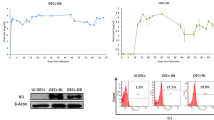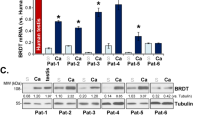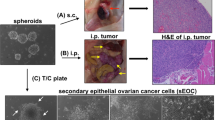Abstract
The risk of developing ovarian cancer is about 1% over a lifetime, but it is the most deadly gynecologic cancer, in part due to lack of diagnostic markers for early-stage disease and cell model system for studying early neoplastic changes. Most existing immortal human ovarian surface epithelial cells were achieved by using viral protein such as SV40 T/t antigen or E6/E7, which inactivate multiple cellular pathways. In the current study, we used a small interfering RNA (siRNA) against the retinoblastoma gene (pRb) and ectopic expression of human telomerase reverse transcriptase (hTERT) to immortalize the primary ovarian epithelial cell line OSE137 and two additional human ovarian surface epithelial cells. The immortalized OSE137 showed increased telomerase activity, lengthened telomeres, increased G2/M phase, altered cell-cycle regulatory proteins but nontumorigenic. As both Rb and hTERT pathways are commonly altered in human ovarian cancer and these genetic changes are faithfully modeled in these cells without using viral protein, these immortal cells represent an authentic in vitro model system with which to study the initiation and progression of human ovarian cancer.
This is a preview of subscription content, access via your institution
Access options
Subscribe to this journal
Receive 50 print issues and online access
$259.00 per year
only $5.18 per issue
Buy this article
- Purchase on Springer Link
- Instant access to full article PDF
Prices may be subject to local taxes which are calculated during checkout





Similar content being viewed by others
Abbreviations
- hTERT:
-
human telomerase reverse transcriptase
- pRb:
-
retinoblastoma protein
- TRAP:
-
telomeric repeat amplification protocol
References
Aprelikova ON, Fang BS, Meissner EG, Cotter S, Campbell M, Kuthiala A et al. (1999). BRCA1-associated growth arrest is RB-dependent. Proc Natl Acad Sci USA 96: 11866–11871.
Baege AC, Berger A, Schlegel R, Veldman T . (2002). Cervical epithelial cells transduced with the papillomavirus E6/E7 oncogenes maintain stable levels of oncoprotein expression but exhibit progressive, major increases in hTERT gene expression and telomerase activity. Am J Pathol 160: 1251–1257.
Band V . (1998). The role of retinoblastoma and p53 tumor suppressor pathways in human mammary epithelial cell immortalization. Int J Oncol 12: 499–507.
Bantounas I, Phylactou LA, Uney JB . (2004). RNA interference and the use of small interfering RNA to study gene function in mammalian systems. J Mol Endocrinol 33: 545–557.
Bernues J, Beltran R, Azorin F . (1991). SV40 recombinants carrying a d(CT.GA)22 sequence show increased genomic instability. Gene 108: 269–274.
Chun YM, Moon SK, Lee HY, Webster P, Brackmann DE, Rhim JS et al. (2002). Immortalization of normal adult human middle ear epithelial cells using a retrovirus containing the E6/E7 genes of human papillomavirus type 16. Ann Otol Rhinol Laryngol 111: 507–517.
D'Andrilli G, Kumar C, Scambia G, Giordano A . (2004). Cell cycle genes in ovarian cancer: steps toward earlier diagnosis and novel therapies. Clin Cancer Res 10: 8132–8141.
Davies BR, Steele IA, Edmondson RJ, Zwolinski SA, Saretzki G, von Zglinicki T et al. (2003). Immortalisation of human ovarian surface epithelium with telomerase and temperature-sensitive SV40 large T antigen. Exp Cell Res 288: 390–402.
Duensing S, Munger K . (2002). Human papillomaviruses and centrosome duplication errors: modeling the origins of genomic instability. Oncogene 21: 6241–6248.
Ferrandina G, Stoler A, Fagotti A, Fanfani F, Sacco R, De Pasqua A et al. (2000). p21WAF1/CIP1 protein expression in primary ovarian cancer. Int J Oncol 17: 1231–1235.
Gao Q, Singh L, Kumar A, Srinivasan S, Wazer DE, Band V . (2001). Human papillomavirus type 16 E6-induced degradation of E6TP1 correlates with its ability to immortalize human mammary epithelial cells. J Virol 75: 4459–4466.
Hashiguchi Y, Tsuda H, Yamamoto K, Inoue T, Ishiko O, Ogita S . (2001). Combined analysis of p53 and RB pathways in epithelial ovarian cancer. Hum Pathol 32: 988–996.
Hayflick L . (1973). Subculturing human diploid fibroblast cultures. In: Kruse Jr PF, Patterson Jr MK (eds). Tissue Culture Methods and Applications. Academic Press: New York. pp 220–223.
Hu Y, Rosen DG, Zhou Y, Feng L, Yang G, Liu J et al. (2005). Mitochondrial manganese-superoxide dismutase expression in ovarian cancer: role in cell proliferation and response to oxidative stress. J Biol Chem 280: 39485–39492.
Iftner T, Elbel M, Schopp B, Hiller T, Loizou JI, Caldecott KW et al. (2002). Interference of papillomavirus E6 protein with single-strand break repair by interaction with XRCC1. EMBO J 21: 4741–4748.
Jarrard DF, Sarkar S, Shi Y, Yeager TR, Magrane G, Kinoshita H et al. (1999). p16/pRb pathway alterations are required for bypassing senescence in human prostate epithelial cells. Cancer Res 59: 2957–2964.
Kauff ND, Mitra N, Robson ME, Hurley KE, Chuai S, Goldfrank D et al. (2005). Risk of ovarian cancer in BRCA1 and BRCA2 mutation-negative hereditary breast cancer families. J Natl Cancer Inst 97: 1382–1384.
Kusakari T, Kariya M, Mandai M, Tsuruta Y, Hamid AA, Fukuhara K et al. (2003). C-erbB-2 or mutant Ha-ras induced malignant transformation of immortalized human ovarian surface epithelial cells in vitro. Br J Cancer 89: 2293–2298.
Kusume T, Tsuda H, Kawabata M, Inoue T, Umesaki N, Suzuki T et al. (1999). The p16-cyclin D1/CDK4-pRb pathway and clinical outcome in epithelial ovarian cancer. Clin Cancer Res 5: 4152–4157.
Lenferink AE, Simpson JF, Shawver LK, Coffey RJ, Forbes JT, Arteaga CL . (2000). Blockade of the epidermal growth factor receptor tyrosine kinase suppresses tumorigenesis in MMTV/Neu + MMTV/TGF-alpha bigenic mice. Proc Natl Acad Sci USA 97: 9609–9614.
Liu J, Fanning CV . (2001). Can renal oncocytomas be distinguished from renal cell carcinoma on fine-needle aspiration specimens? A study of conventional smears in conjunction with ancillary studies. Cancer 93: 390–397.
Liu J, Yang G, Thompson-Lanza JA, Glassman A, Hayes K, Patterson A et al. (2004). A genetically defined model for human ovarian cancer. Cancer Res 64: 1655–1663.
Lundberg AS, Randell SH, Stewart SA, Elenbaas B, Hartwell KA, Brooks MW et al. (2002). Immortalization and transformation of primary human airway epithelial cells by gene transfer. Oncogene 21: 4577–4586.
McDougall JK . (2001). Telomerase activity and cellular immortalization. Dev Biol (Basel) 106: 267–272 discussion 272–3, 317–29.
Noble JR, Zhong ZH, Neumann AA, Melki JR, Clark SJ, Reddel RR . (2004). Alterations in the p16(INK4a) and p53 tumor suppressor genes of hTERT-immortalized human fibroblasts. Oncogene 23: 3116–3121.
Ouellette MM, McDaniel LD, Wright WE, Shay JW, Schultz RA . (2000). The establishment of telomerase-immortalized cell lines representing human chromosome instability syndromes. Hum Mol Genet 9: 403–411.
Ozols RF, Bookman MA, Connolly DC, Daly MB, Godwin AK, Schilder RJ et al. (2004). Focus on epithelial ovarian cancer. Cancer Cell 5: 19–24.
Plug-Demaggio AW, McDougall JK . (2002). The human papillomavirus type 16 E6 oncogene induces premature mitotic chromosome segregation. Oncogene 21: 7507–7513.
Prowse A, Frolov A, Godwin AK . (2003). The genetics of ovarian cancer. In: Ozols RF (ed). American Cancer Society Atlas of Clinical Oncology. B.C. Decker Inc: Hamilton, Ontario. pp 49–82.
Rosen DG, Yang G, Cai KQ, Bast Jr RC, Gershenson DM, Silva EG et al. (2005). Subcellular localization of p27kip1 expression predicts poor prognosis in human ovarian cancer. Clin Cancer Res 11 (2 Part 1): 632–637.
Sage J, Mulligan GJ, Attardi LD, Miller A, Chen S, Williams B et al. (2000). Targeted disruption of the three Rb-related genes leads to loss of G(1) control and immortalization. Genes Dev 14: 3037–3050.
Sankaranarayanan R, Ferlay J . (2006). Worldwide burden of gynaecological cancer: the size of the problem. Best Pract Res Clin Obstet Gynaecol 20: 1–19.
Takebayashi T, Higashi H, Sudo H, Ozawa H, Suzuki E, Shirado O et al. (2003). NF-kappa B-dependent induction of cyclin D1 by retinoblastoma protein (pRB) family proteins and tumor-derived pRB mutants. J Biol Chem 278: 14897–14905.
Tammela J, Odunsi K . (2004). Gene expression and prognostic significance in ovarian cancer. Minerva Ginecol 56: 495–502.
Terasawa K, Sagae S, Takeda T, Ishioka S, Kobayashi K, Kudo R . (1999). Telomerase activity in malignant ovarian tumors with deregulation of cell cycle regulatory proteins. Cancer Lett 142: 207–217.
Vasey PA . (2003). Resistance to chemotherapy in advanced ovarian cancer: mechanisms and current strategies. Br J Cancer 89 (Suppl 3): S23–S28.
Xiang H, Wang J, Mao Y, Liu M, Reddy VN, Li DW . (2002). Human telomerase accelerates growth of lens epithelial cells through regulation of the genes mediating RB/E2F pathway. Oncogene 21: 3784–3791.
Yang G, Cai KQ, Thompson-Lanza JA, Bast Jr RC, Liu J . (2004). Inhibition of breast and ovarian tumor growth through multiple signaling pathways by using retrovirus-mediated small interfering RNA against Her-2/neu gene expression. J Biol Chem 279: 4339–4345.
Zou GM, Yoder MC . (2005). Application of RNA interference to study stem cell function: current status and future perspectives. Biol Cell 97: 211–219.
Acknowledgements
This work was supported in part by a research scholar grant from the American Cancer Society (JL) and Cancer Center Core grant (CA016672) from the National Cancer Institute (MD Anderson Cancer Center). We thank Drs Sandy Chang and Asha Multani from the MD Anderson Molecular Cytogenetics Core Facility for karyotyping the immortalized cells.
Author information
Authors and Affiliations
Corresponding author
Rights and permissions
About this article
Cite this article
Yang, G., Rosen, D., Colacino, J. et al. Disruption of the retinoblastoma pathway by small interfering RNA and ectopic expression of the catalytic subunit of telomerase lead to immortalization of human ovarian surface epithelial cells. Oncogene 26, 1492–1498 (2007). https://doi.org/10.1038/sj.onc.1209905
Received:
Revised:
Accepted:
Published:
Issue Date:
DOI: https://doi.org/10.1038/sj.onc.1209905
Keywords
This article is cited by
-
A prospect of cell immortalization combined with matrix microenvironmental optimization strategy for tissue engineering and regeneration
Cell & Bioscience (2019)
-
A novel function of colony-stimulating factor 1 receptor in hTERT immortalization of human epithelial cells
Oncogene (2009)
-
Retrovirally mediated telomerase immortalization of neural progenitor cells
Nature Protocols (2007)



